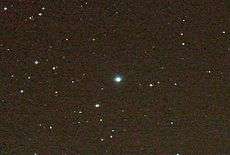19 Aquilae
19 Aquilae is a single[12] star located 142 light-years (44 parsecs) away from the Sun in the equatorial constellation of Aquila. 19 Aquilae is the Flamsteed designation. It is visible to the naked eye as a dim, yellow-white hued star with an apparent visual magnitude of 5.23.[2] The star is moving closer to the Earth with a heliocentric radial velocity of −46.7 km/s.[7]
 Image captured from Mount Laguna, California | |
| Observation data Epoch J2000.0 Equinox J2000.0 | |
|---|---|
| Constellation | Aquila |
| Right ascension | 19h 08m 59.90684s[1] |
| Declination | +06° 04′ 23.4857″[1] |
| Apparent magnitude (V) | 5.227[2] |
| Characteristics | |
| Spectral type | F0 III-IV[3] |
| Apparent magnitude (U) | 5.59±0.010[4] |
| Apparent magnitude (B) | 5.57±0.007[5] |
| Apparent magnitude (V) | 5.23±0.009[5] |
| U−B color index | +0.020[2] |
| B−V color index | +0.345[2] |
| Variable type | suspected γ Dor[6] |
| Astrometry | |
| Radial velocity (Rv) | −46.7[7] km/s |
| Proper motion (μ) | RA: −5.485[1] mas/yr Dec.: −73.785[1] mas/yr |
| Parallax (π) | 22.9563 ± 0.2397[1] mas |
| Distance | 142 ± 1 ly (43.6 ± 0.5 pc) |
| Absolute magnitude (MV) | 1.94[8] |
| Details | |
| Mass | 1.54[9] M☉ |
| Radius | 2.50+0.25 −0.05[1] R☉ |
| Luminosity | 12.8±0.2[1] L☉ |
| Surface gravity (log g) | 4.13[3] cgs |
| Temperature | 6,784±53[9] K |
| Metallicity [Fe/H] | +0.03[3] dex |
| Rotational velocity (v sin i) | 57.0[10] km/s |
| Age | 2.25[9] Gyr |
| Other designations | |
| Database references | |
| SIMBAD | data |
This object has a stellar classification of F0 III-IV,[3] with the luminosity class matching an evolving star transitioning from the subgiant to a giant stage. Poretti et al. (2003) list it as a suspected Gamma Doradus variable, and it is located near the cooler end of the instability strip on the Hertzsprung–Russell diagram.[6] These spatial coordinates are a source of X-ray emission, which is most likely coming from the star.[13]
19 Aquilae is an estimated 2.25[9] billion years old with a moderately high rate of spin, showing a projected rotational velocity of 57.0 km/s.[10] It has 1.54[9] times the mass of the Sun and 2.50[1] times the Sun's radius. The star is radiating 12.8[1] times the luminosity of the Sun from its photosphere at an effective temperature of 6,784 K.[9]
References
- Brown, A. G. A.; et al. (Gaia collaboration) (August 2018). "Gaia Data Release 2: Summary of the contents and survey properties". Astronomy & Astrophysics. 616. A1. arXiv:1804.09365. Bibcode:2018A&A...616A...1G. doi:10.1051/0004-6361/201833051. Gaia DR2 record for this source at VizieR.
- Oja, T. (1986). "UBV photometry of stars whose positions are accurately known. III". Astronomy and Astrophysics Supplement Series. 65 (2): 405–4. Bibcode:1986A&AS...65..405O.
- Balachandran, Suchitra (May 1, 1990). "Lithium depletion and rotation in main-sequence stars". Astrophysical Journal, Part 1. 354: 310–332. Bibcode:1990ApJ...354..310B. doi:10.1086/168691.
- Oja, T. (1984). "UBV photometry of stars whose positions are accurately known". Astronomy and Astrophysics Supplement Series. 57: 357. Bibcode:1984A&AS...57..357O.
- Oja, T. (September 1993). "UBV photometry of stars whose positions are accurately known. VII". Astronomy and Astrophysics Supplement Series. 100 (3): 591–592. Bibcode:1993A&AS..100..591O. ISSN 0365-0138.
- Poretti, E.; et al. (2003). "Preparing the COROT space mission: Incidence and characterisation of pulsation in the lower instability strip". Astronomy and Astrophysics. 406: 203. arXiv:astro-ph/0304422. Bibcode:2003A&A...406..203P. doi:10.1051/0004-6361:20030711.
- Wielen, R.; et al. (1999). "Sixth Catalogue of Fundamental Stars (FK6). Part I. Basic fundamental stars with direct solutions". Veröffentlichungen Astronomisches Rechen-Institut Heidelberg. Astronomisches Rechen-Institut Heidelberg. 35 (35). Bibcode:1999VeARI..35....1W.
- Holmberg, J.; et al. (July 2009). "The Geneva-Copenhagen survey of the solar neighbourhood. III. Improved distances, ages, and kinematics". Astronomy and Astrophysics. 501 (3): 941–947. arXiv:0811.3982. Bibcode:2009A&A...501..941H. doi:10.1051/0004-6361/200811191.
- Luck, R. Earle (2015). "Abundances in the Local Region. I. G and K Giants". Astronomical Journal. 150 (3): 88. arXiv:1507.01466. Bibcode:2015AJ....150...88L. doi:10.1088/0004-6256/150/3/88.
- Schröder, C.; Reiners, A.; Schmitt, J. H. M. M. (January 2009). "Ca II HK emission in rapidly rotating stars. Evidence for an onset of the solar-type dynamo" (PDF). Astronomy and Astrophysics. 493 (3): 1099–1107. Bibcode:2009A&A...493.1099S. doi:10.1051/0004-6361:200810377. Retrieved 2019-06-01.
- "19 Aql". SIMBAD. Centre de données astronomiques de Strasbourg. Retrieved 2019-05-30.
- Eggleton, P. P.; Tokovinin, A. A. (2008). "A catalogue of multiplicity among bright stellar systems". Monthly Notices of the Royal Astronomical Society. 389 (2): 869. arXiv:0806.2878. Bibcode:2008MNRAS.389..869E. doi:10.1111/j.1365-2966.2008.13596.x.
- Haakonsen, Christian Bernt; Rutledge, Robert E. (September 2009). "XID II: Statistical Cross-Association of ROSAT Bright Source Catalog X-ray Sources with 2MASS Point Source Catalog Near-Infrared Sources". The Astrophysical Journal Supplement. 184 (1): 138–151. arXiv:0910.3229. Bibcode:2009ApJS..184..138H. doi:10.1088/0067-0049/184/1/138.